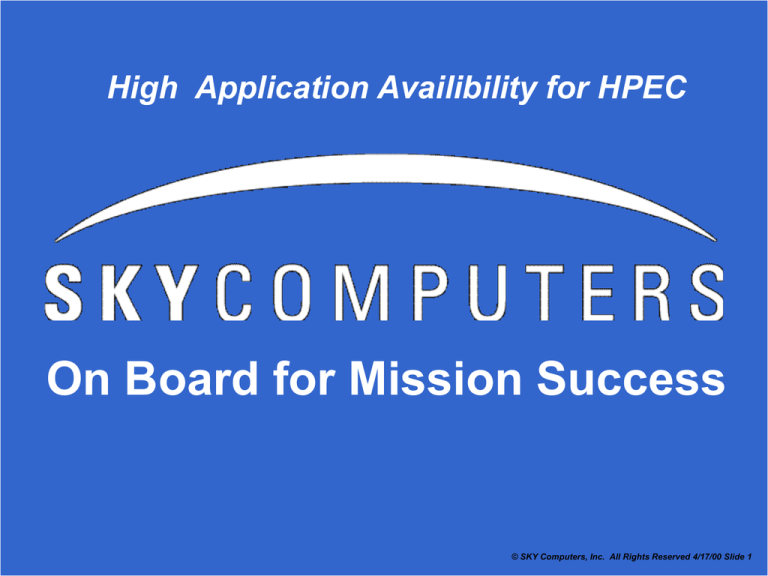
High Application Availibility for HPEC
On Board for Mission Success
© SKY Computers, Inc. All Rights Reserved 4/17/00 Slide 1
High Application Availability
Percentage of time primary application is
available
MTBF
MTBF+MTTR
Common requirement is “5-9’s” - 99.999%
About 5 minutes down time per year
Failures caused by hardware, software or user
Large HPEC system may have an MTBF of a
few weeks
© SKY Computers, Inc. All Rights Reserved 4/17/00 Slide 2
System Design
Total system - hardware, system software and
application - must be designed for HAA
Typically n+m design in HPEC
For each resource, n required for application
m additional provided for redundancy
Resources must be carefully identified - processors,
memory, fans, power supplies, fabric connections, …
Recovery MUST be “automatic”
Don’t have time for human involvement
© SKY Computers, Inc. All Rights Reserved 4/17/00 Slide 3
Availability
100000.000
10000.000
1000.000
100.000
10.000
1.000
0.100
0.010
1
0.001
© SKY Computers, Inc. All Rights Reserved 4/17/00 Slide 4
Maximize MTBF
Prevent failures
Careful electrical design
ECC/CRC error detection/correction
Good mechanical design including cooling
Good software design
Exhaustive test/debug
Preempt failures
Online testing
Health monitoring
Temperatures, fan speeds, voltages
Opportunity to repair system before actual failure
© SKY Computers, Inc. All Rights Reserved 4/17/00 Slide 5
Fault Management
Detection - determine that fault exists
Diagnosis - identify failing component
Isolation - protect rest of system from failures
Recovery - get application running again
Repair - replace or restart failing component
© SKY Computers, Inc. All Rights Reserved 4/17/00 Slide 6
Fault Management
Detection
Hardware detected - ECC/parity errors, link status
change, …
Software detected - timeouts, inconsistent answers, …
Must be detectable by reliable resource
Diagnosis
Identify failed resource(s)
Repair not needed if n resources still available
© SKY Computers, Inc. All Rights Reserved 4/17/00 Slide 7
Fault Management
Isolation
InfiniBand “automatic path migration” to use alternate
path through fabric
Software re-configuration of routing tables in InfiniBand
switches
Remove processors from CORBA scheduler
Other application specific choices
Recovery
Restart/resume the application with reduced
configuration
Detection to Recovery can be accomplished in a fraction
of a second, perhaps milliseconds depending on failure
© SKY Computers, Inc. All Rights Reserved 4/17/00 Slide 8
Fault Management
Repair
Since most likely root cause is software fault,
reset/restart may be all that is required
Run detailed diagnostic
Verify failure and locate Field Replaceable Unit (FRU)
Return still functional resources to use
Technician replaces FRU
InfiniBand supports “Live Insertion”
Return repaired component to use
© SKY Computers, Inc. All Rights Reserved 4/17/00 Slide 9
Some Resources
Service Availability Forum
http://developer.intel.com/platforms/applied/eiacomm/saforum.htm
Linux High Availability Project
http://linux-ha.org
Real-time CORBA, Dynamic Scheduling
http://www.omg.org
Telco oriented High Availability
http://www.goahead.com/products/products.htm
http://www.ccpu.com/telco_products/middleware.html
http://www.mvista.com/cge/index.html
© SKY Computers, Inc. All Rights Reserved 4/17/00 Slide 10
Conclusion
HAA requires careful SYSTEM level
analysis/design - hardware, system software
and application must ALL cooperate
Emerging fabrics like InfiniBand enable HAA
capabilities not available previously for HPEC
applications
5 step fault management process useful for
design of HAA applications
© SKY Computers, Inc. All Rights Reserved 4/17/00 Slide 11






